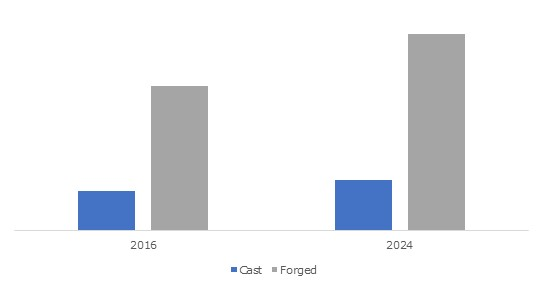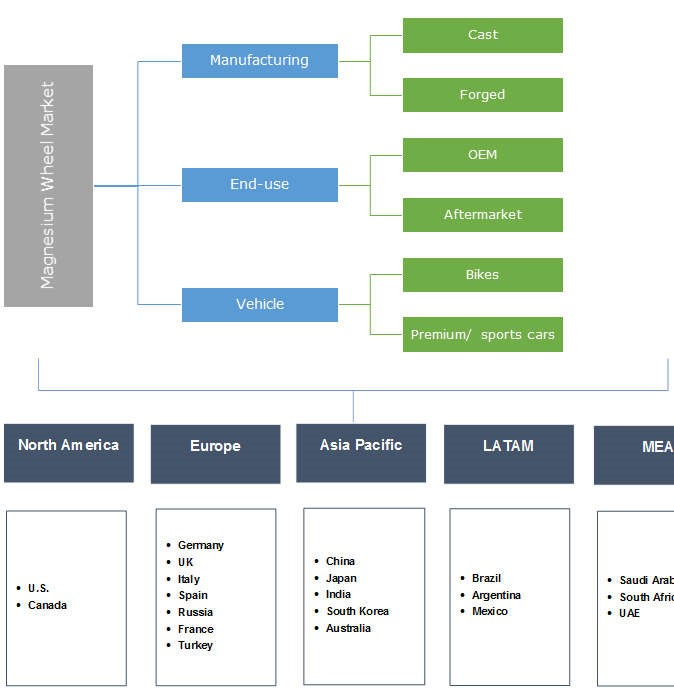
End-Use (OEM, Aftermarket), By
Vehicle (Bikes, Premium/ Sports Cars),
Industry Analysis Report,
Regional Outlook (U.S., Canada, Germany, UK,
Italy, Spain, Russia, France,
Turkey, China, Japan, India, South Korea, Australia, Brazil, Argentina, Mexico,
Saudi Arabia, South Africa, UAE),
Growth Potential, Price Trends,
Competitive Market Share & Forecast,
2017 – 2024
Magnesium
Wheel Market size was worth over USD 22.1 billion
in 2016 and will surpass 76.2 million units by 2024.
U.S. Magnesium Wheel
Market, By Manufacturing, 2013 – 2024
(Thousand Units)
 Shifting trend towards light weight
vehicles along with increased road safety concerns will propel the magnesium
wheel market size. Inclination towards enhanced driving experience accompanied
by increasing replacement of traditional steel by efficient & durable
magnesium material will drive the product demand.
Shifting trend towards light weight
vehicles along with increased road safety concerns will propel the magnesium
wheel market size. Inclination towards enhanced driving experience accompanied
by increasing replacement of traditional steel by efficient & durable
magnesium material will drive the product demand.
Growing automotive industry due to rising
vehicle demand along with increasing consumer spending will support the
industry growth. As per analysis, in
2016 U.S. passenger car sales reached 6 million, while only 4 million cars were
manufactured in the country. Changing automotive trends including vehicle
customization, improved fuel efficiency and reduced weight are the key factors
positively influencing the product penetration.
Increasing preference for green mobility
coupled with stringent regulations promoting lightweight automotive components
has enhanced the industry demand. According to California Vehicle Code (CVC),
gross weight on any wheel should not surpass 10,500 pounds. For every 100
pounds of vehicle weight reduction, there is an average decrease of about 2%
fuel consumption. Rising demand for hybrid and electric vehicles will drive the
industry growth, as weight reduction is major concern in hybrid automobiles.
Increasing R&D spending along with
technological innovations are the driving factors for business growth. Rising
product demand from premium compact vehicles, sports cars and premium motorcycles
will propel the magnesium wheel market. Weight reduction, enhanced vehicle
braking system and improved acceleration are the significant benefits fueling
the industry demand.
Economic instability, stagnant industry
growth and fluctuating raw material costs are the key factors affecting
magnesium wheel price trend. However, excessive costs associated with initial
set up and repair may hamper the industry growth.
Cast manufacturing was valued over USD 5.6
billion in 2016. Low production cost and easier manufacturing process are the
supporting factors of industry demand. However, comparatively heavier weight
along with manufacturing defects including pores, cavities and metallurgical
microstructure causing large grain size may restrain the segment growth.
Forged manufacturing accounted for over
71% of the overall industry share in 2016. High durability, lightweight,
rigidity, strength and easy repairing are the key properties driving the
industry growth. Forged magnesium wheel are around 1.5 times lighter compared
to aluminum and 2.2 times lighter relative to steel. Moreover, absence of
casting defects including cracks and bends provides a positive outlook for product
demand.
OEM market generated over 39.8 million
units and is anticipated to exhibit major industry share by 2024. Shifting
manufacturer preference for vehicle weight reduction is the key driving factor
for magnesium wheel market growth. Product innovations and development coupled
with heavy R&D investment by OEMs will propel industry demand.
Magnesium wheel aftermarket will witness
CAGR over 4.5% from 2017 to 2024. Increasing product replacement frequency
particularly for passenger cars will support the industry growth. Shifting
trend for vehicle customization and lightweight automotive components have
enhanced the product demand. Rise in rate of vehicle accidents due to poor road
conditions and lack of stringent regulations in several countries will drive
the business growth. Moreover, favorable insurance schemes will support the
product demand.
Bikes market was worth over USD 520
million in 2016. Increasing road congestion due to rising population is the key
factor fueling the industry growth. Changing income trends along with
increasing preference for motorbikes has enhanced the product demand. Superior
product properties including lower overheating, high strength and relatively
light weight will propel the magnesium wheel market from bikes.
Premium/ sports cars will value over USD
27.8 billion by 2024. Rising demand for premium & luxury vehicles
particularly in North America and Western Europe will drive the industry
growth. Necessity for superior quality products to enhance acceleration and
quick braking are the key factors supporting product demand.
Europe accounted for over 40% of the
magnesium wheel market share in 2016. Recovery of automobile sector along with
increasing penetration of premium cars particularly in UK, Germany, Italy,
Spain and Poland will drive the regional demand. Presence of premium automotive
manufacturers including Lamborghini, Ferrari, Audi, BMW and Porsche provides a
positive outlook for industry growth.
Asia Pacific magnesium wheel market
revenue is anticipated to surpass USD 8.2 billion by 2024. Growing automotive
production due to favorable socio-economic conditions for manufacturing
facilities will propel the industry growth. Increasing penetration of premium
& luxury vehicles particularly in Japan and China will drive the product
scope. Moreover, initiatives by Japanese associations to improve product
quality will further support the industry demand.
North America will witness gains over 3.5%
up to 2024. Stringent emission norms coupled with government initiatives
promoting lightweight vehicles will drive the demand. High disposable income
and improved standard of living are the key factors enhancing premium vehicle
demand.
BBS, Enkei, MKW Alloy, SMW Engineering and
O.Z. Group are among the prominent players in magnesium wheel market share.
Industry players mainly focus on collaborations with high end premium car
manufacturers to increase customer base and strengthen foothold. For instance,
O.Z. Group partnered with leading OEMs including Ferrari, Volkswagen, Mercedes
Benz, etc. In August 2016, the company renewed its partnership with Ferrari
till 2019.
Product positioning for sport and premium
car manufacturers is the major strategy observed. For instance, BBS have
focused its supply for sports cars used in Formula One. Similarly, Enkei
Corporation developed products suitable for sportscars adopting the stringent
JGTC regulations. Moreover, technological advancement and heavy R&D
investment are among other strategies adopted. For instance, in 2016, SMW
Engineering launched research & development projects to perform in depth
analysis of environmental & economic benefits of magnesium wheel.

 |
Stringent regulations for emission
reduction and usage of light weight vehicles has been a major driver for
industry growth. For instance, EC has set target of automobile emissions
reduction to reach 175g CO2/km by 2017 and 147 g CO2/km by 2020 for lightweight
vehicles. JAWA aims at improving quality of light alloy materials promoting
product penetration in automotive aftermarket.
